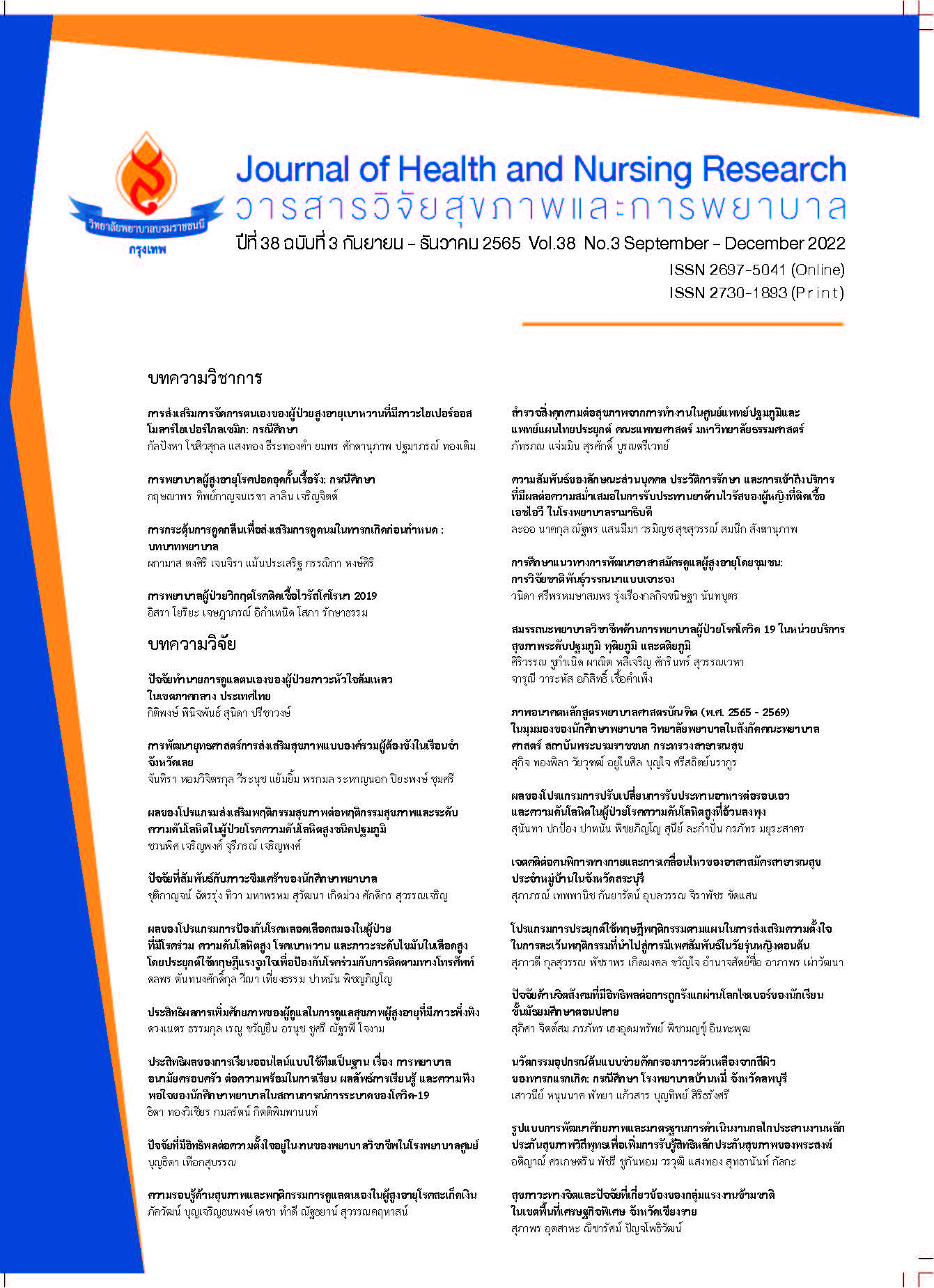การส่งเสริมการจัดการตนเองของผู้ป่วยสูงอายุเบาหวานที่มี ภาวะไฮเปอร์ออสโมลาร์ไฮเปอร์ไกลเซมิก: กรณีศึกษา
คำสำคัญ:
การส่งเสริมการจัดการตนเอง , เบาหวาน , สุขภาพ, ผู้สูงอายุ, ภาวะไฮเปอร์ออสโมลาร์ไฮเปอร์ไกลเซมิกบทคัดย่อ
บทนำ: ผู้ป่วยผู้สูงอายุที่เป็นเบาหวานที่ไม่สามารถควบคุมระดับน้ำตาลเป็นระยะเวลานานส่งผลให้เกิดภาวะแทรกซ้อนแบบเฉียบพลัน คือ ภาวะเลือดเป็นกรด (Diabetic Ketoacidosis: DKA) และภาวะไฮเปอร์ออสโมลาร์ไฮเปอร์ไกลเซมิก (Hyperosmolar Hyperglycemic State: HHS) โดยอาการที่พบบ่อยของภาวะไฮเปอร์ออสโมลาร์ไฮเปอร์ไกลเซมิก คือ มึนงง ใจสั่น เหนื่อย คลื่นไส้ แต่ไม่พบอาการหายใจหอบลึก หายใจลำบาก และภาวะเลือดเป็นกรด ระดับน้ำตาลในเลือดสูงมากกว่า 600 mg/dl และค่า serum osmolality มากกว่า 300 mOsm/L
วัตถุประสงค์: เพื่อส่งเสริมการจัดการตนเองของผู้ป่วยผู้สูงอายุที่มีภาวะ HHS ทั้งในขั้นตอนของการรักษาที่โรงพยาบาลและการดูแลต่อเนื่องที่บ้าน
ประเด็นสำคัญ: ภาวะไฮเปอร์ออสโมลาร์ไฮเปอร์ไกลเซมิก เป็นภาวะฉุกเฉินที่มีระดับน้ำตาลในเลือดสูง พบบ่อยในผู้สูงอายุที่ควบคุมระดับน้ำตาลไม่ได้ พยาบาลที่ให้การดูแลจำเป็นต้องประเมินและวิเคราะห์ปัจจัยต่าง ๆ ที่มีผลต่อการเกิดน้ำตาลสูง เพื่อให้วางแผนการพยาบาลได้อย่างครอบคลุม ช่วยลดภาวะแทรกซ้อน และลดอัตราการเสียชีวิตของผู้ป่วย
สรุป: การดูแลผู้ป่วยสูงอายุที่เป็นเบาหวานที่ควบคุมระดับน้ำตาลไม่ได้เป็นการดูแลที่ซับซ้อน ควรออกแบบการดูแลที่สอดคล้องกับสภาพปัญหาเฉพาะราย ตั้งแต่การรักษา ส่งต่อ และติดตามดูแลต่อเนื่อง ที่บ้าน มุ่งเน้นการมีส่วนร่วมของครอบครัว โดยมีผู้ป่วยเป็นศูนย์กลางในการจัดการตนเอง
ข้อเสนอแนะ : พยาบาลควรวิเคราะห์และค้นหาสาเหตุปัญหาการเกิดน้ำตาลสูง เพื่อนำไปสู่การพัฒนาระบบการดูแล การป้องกันการเกิดภาวะไฮเปอร์ออสโมลาร์ไฮเปอร์ไกลเซมิก นอกจากนั้นพยาบาลควรจะให้ความสำคัญต่อการส่งเสริมการจัดการตนเองและสร้างการมีส่วนร่วมของครอบครัว เพื่อลดระดับน้ำตาลในระยะยาว
Downloads
เอกสารอ้างอิง
Chawla A, Chawla R, Jaggi S. Microvasular and macrovascular complications in diabetes mellitus: Distinct or Continuum Indian J Endocrinol Metab 2016;20(4):546-551.
International Diabetes Federation. IDF diabetes atlas 10th edition [Internet]. 2021 [cited 2022 Sep 29]. Available from: https://diabetesatlas.org/idfawp/resource-files/2021/07/IDF_Atlas_10th_Edition_2021.pdf
Kanchanaphibunwong A, Khamwangsanga P, Kaewtha S. NCDs situation report diabetes, high blood pressure and related risk factors. Technology, Epidemiology and Community Measures Division of Non-Communicable Diseases,Department of Disease Control, Ministry of Public Health.Graphic and Design typography. 2020.
Lima VC, Cavalieri GC, Lima MC, Nazario NO, Lima GC. Risk factors for diabetic retinopathy: a case-control study. International Journal of Retina and Vitreous 2016; 2(1):21-7.
Papatheodorou K, Banach M, Bekiari E, Rizzo M, Edmonds M. Complications of Diabetes. J Diabetes Res 2018;2018:3086167.
Phuwong Y, Pinitsoontorn S. Complication among diabetes patients in a selected community hospital in the northeast. Journal of Community Health Development Quarterly Khon Kaen University 2014;2(3):313-319. (in Thai).
Wachirarangsiman K, Peeracheir S. Clinical characteristic, vital sign, precipitating factor and outcome of DKA and HHS patient in emergency department of general hospital. Chiangrai Medical Journal 2022;14(2):131-146. (in Thai)
Sirikutjatuporn K, Wirojratana V, Jitramontree N. Factors predicting self-management behaviour of elderly type 2 diabetes patients. Thai Journal of Nursing Council 2017;32(1):81-93. (in Thai)
Broadley L, Clark K, Ritchie G. Prevention and management of hyperglycaemic crisis. Nurs Stand 2019;34(7):75-82.
Piboon K, Jaidee W, Chailkongkit K. A systematic review of type 2 diabetic care intervention among elderly people. The Journal of Faculty of Nursing Burapha University 2015;23(2):1-19. (in Thai).
Runnun S, Loaseena P. The development of a Clinical Nursing Practice Guideline (CNPG) for self-management support on type 2 diabetes mellitus patients that cannot control their blood sugar level, Kantharawichai hospital, Maha Sarakham province. Mahasarakham Hospital Journal 2019;16(3):139-148 (in Thai).
Karslioglu French E, Donihi AC, Korytkowski MT. Diabetic ketoacidosis and hyperosmolar hyperglycemic syndrome: Review of acute decompensated diabetes in adult patients. BMJ. 2019;365:I1114.
Mohammed A, Namareq A F, Nada A, Mohammed SA, Alhammad AM, Abdulrahman AI. Updates in the management of hyperglycemic crisis. Journal Frontiers in Clinical Diabetes and Healthcare 2022;(2):1-8.
Waisayanand N, Suksatit B. Self-Administration of insulin among persons with type 1 diabetes mellitus. Journal of The Royal Thai Army Nurses 2017;18:11-21. (in Thai).
Mokta JK, Mokta KK, Panda P. Insulin lipodystrophy and lipohypertrophy. Indian J Endocrinol Metab 2013;17(4):773-774.
Al Ajlouni M, Abujbara M, Batieha A, Ajlouni K. Prevalence of lipohypertrophy and associated risk factors in insulin-treated patients with type 2 diabetes mellitus. Int J Endocrinol Metab 2015;13(2):e20776.
Sanloa P,Thanapiyawat N, Sripawariporn S. Self-management in elderly people with diabetes mellitus in Esaan context. Journal of Nursing and Health Care 2019;37(3):221-229. (in Thai).
Surawong S, Choowattanapakorn T. The effect of an individual and family self-management program on HbA1c in older persons with type 2 diabetes mellitus. Journal of Nursing Science Chulalongkorn University 2017;29(1):104-116. (in Thai).
Duangklad K, Lapvongwatana P, Chansatitporn N. Improvement of self-management program in uncontrolled type II diabetes patients. Journal of Health and Nursing Research 2020;36(1):66-81. (in Thai).
Ruangdet. M, Surit P. Systematic review on self-management interventions of diabetes mellitus patients with comorbidities. Journal of Nursing and Health Care 2018; 36(4):138-145.
Potirud T, Pranfan S, SongKror K. Effects of the self-management supporting program on self-management behaviors and HbA1c level among persons with type 2 diabetes mellitus at Chiang Klang hospital, Nan province. Thai Journal of Nursing 2020;69(2):11-20. (in Thai)
Printrakun R, Songthap A. Factors affecting insulin injecting behaviors among type 2 diabetic patients in Long hospital, Long district, Phrae province. Thai Journal of Pharmacy Practice 2021;13(2):345-55. (in Thai).
ดาวน์โหลด
เผยแพร่แล้ว
รูปแบบการอ้างอิง
ฉบับ
ประเภทบทความ
สัญญาอนุญาต
ลิขสิทธิ์ (c) 2022 วารสารวิจัยสุขภาพและการพยาบาล (วารสารวิทยาลัยพยาบาลบรมราชชนนี กรุงเทพ)

อนุญาตภายใต้เงื่อนไข Creative Commons Attribution-NonCommercial 4.0 International License.
บทความที่ได้รับการตีพิมพ์ เป็นลิขสิทธิ์ของวารสารวิจัยสุขภาพและการพยาบาล (วิทยาลัยพยาบาลบรมราชชนนี กรุงเทพ) ไม่สามารถนำไปตีพิมพ์ซ้ำในวารสารฉบับอื่น


















